- Home
- About
- Training Courses
- ASME Classroom & Virtual Courses
- API Classroom Courses
- E-Learning
- ASME Level 1 eLearning - Full Course
- ASME Plant Inspector Level 1 – Block 1 (Intro and Modules 1 and 2)
- ASME Plant Inspector Level 1 – Block 2 (Modules 3-5)
- ASME Plant Inspector Level 1 – Block 3 (Modules 6-8)
- ASME Plant Inspector Level 1 – Final Examination Module
- ASME Level 2 eLearning - Full Course
- ASME Plant Inspector Level 2 – Block 1 (Modules 1-3)
- ASME Plant Inspector Level 2 – Block 2 (Modules 4-7)
- ASME Plant Inspector Level 2 – Block 3 (Modules 8-10)
- ASME Plant Inspector Level 2 – Final Examination
- API 579 Fitness For Service
- API 571 Corrosion and Materials
- API 577 Welding & Metallurgy
- API 580 Risk Based Inspection
- API 510 CPD Training
- API 570 CPD Training
- API SIFE
- API 1169 Pipeline Inspector Certification Course
- API 936 Refractory Personnel Certification
- Technical Courses
- API CPD Recertification
- Training Courses
- Technical Hub
- Virtual Training
- FAQs
- Contact
- Online Training Portal
- Shop
- Privacy Policy
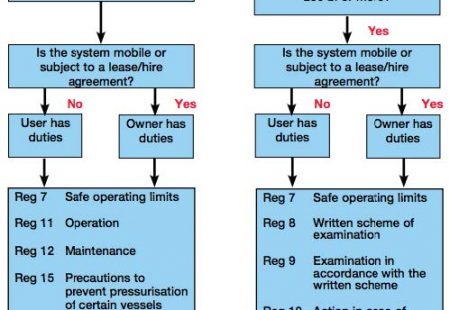
- In: Training | On: Jul 16, 2021
Pressure System Safety Regulations
What are the PSSRs and what do they cover?
The Pressure Systems Safety Regulations 2000 (PSSR) cover the safe design and use of pressure systems with the aim to prevent serious injury from the hazard of stored energy (pressure) as a result of the failure of a pressure system or one of its component parts.
The regulations are concerned with gases that exert a pressure in excess of 0.5 bar above atmospheric pressure or from the scalding effects of steam at any pressure.
Who are they aimed at?
They are aimed at duty holders under PSSR involved with pressure systems used at work. It is for users, owners, competent persons, designers, manufacturers, importers, suppliers and installers of pressure systems used at work.
PSSR regulations often make reference to the user/owner being responsible.
• User/owner means ‘user of an installed system or owner of a mobile system’.
• The user/owner is responsible for PSSR compliance and cannot subcontract that responsibility to anyone else (such as the competent person).
The Approved Code of Practice (ACOP)
This Code has been approved by the Health and Safety Executive, with the consent of the Secretary of State. It gives practical advice on how to comply with the law. If you follow the advice you will be doing enough to comply with the law in respect of those specific matters on which the Code gives advice.
You may use alternative methods to those set out in the Code in order to comply with the law.
However, the Code has a special legal status. If you are prosecuted for breach of health and safety law, and it is proved that you did not follow the relevant provisions of the Code, you will need to show that you have complied with the law in some other way or a Court will find you at fault.
The Health and safety inspectors seek to secure compliance with the law and may refer to this guidance. Since the last edition, the ACOP and guidance have been updated for clarity. The content has not been radically changed, as it was fit for purpose.
The main changes are:
• The decision tree (Figure 1) on whether PSSR applies has been moved to the front of the book and explanatory
notes have been added to it.
• A new Appendix has been added to provide clarity on how to apply PSSR in a proportionate manner to small
pressure vessels in schools.
• The section on the legal background to PSSR and related legislation has been removed as it was out of date.
Note: The actual Regulations have not changed at all, so the responsibilities of the duty-holders remain the same.
How to use the ACOP
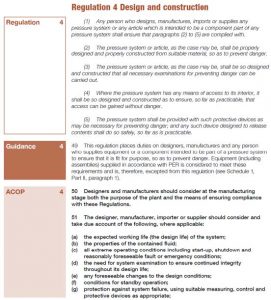
The actual text of the Regulations is in italics
The accompanying guidance is in normal type
The ACOP text is set out in bold
Colour borders indicate each section clearly
Pressure Systems Safety Regulations
What Fluids Do The PSSRs Cover?
The situation regarding stored energy and the effects of scalding by steam is encapsulated by defining these as ‘Relevant Fluids’.
The following conditions have to be fulfilled for a fluid to be classed as a relevant fluid:
• Steam at any pressure.
• Gases >0.5 bar above atmospheric pressure.
• Fluids with a gas or vapour phase > 0.5 bar above atmospheric pressure.
• A gas dissolved under pressure in a solvent contained in a porous substance at ambient temperature and which could be released from the solvent without the application of heat i.e. acetylene.
• Protective devices are covered within the scope of the PSSRs irrespective of whether they contain a relevant fluid, provided they form part of a system that contains or is liable to contain a relevant fluid or steam
Note: Once the pressure along a line of pipework drops below 0.5 bar (gauge) there is no longer a relevant and that part of the pipework and that part of the system is no longer covered by the regulations.
What About the Hazardous Properties of the Fluids?
With the exception of the scalding effects of steam, the regulations do not consider the hazardous properties; toxicity, flammability or how explosive the contents are following a system failure. These properties are the subject of separate legislative requirements namely; COMAH, COSHH etc, to prevent injury or environmental hazards.
The properties of the stored contents are of concern to the duty-holder only to the extent that they may cause the rapid deterioration in the condition of the system, increasing the risk of failure.
The regulations do not apply as a result of pressure exerted by a head of liquid (i.e. storage tanks) or vacuum conditions.
What is Stored Energy?
The amount of stored energy in a vessel is related to the volume of the vessel and the pressure of the contents.
The stored energy can only be contained in a fluid that is compressible (i.e. a gas, vapour or mixture of a gas/ vapour or liquid phase.
Pure liquid (water) is compressible to a very small amount (approximately <1%) which is not very significant.
The minimum pressure x volume limit is 250 bar litres (except for steam, where there is no limit).
To determine the amount of stored energy (capacity) multiply the pressure by the internal volume (P x V).
If the values used are:
• Pressure = Bar
• Volume = litres
Note: Then the stored energy is given in bar litres (bl).
The decision tree that aids the process in deciding if the PSSRs apply is overleaf.
• The diagram only covers type (a) pressure systems, as defined in regulation 2(1) under ‘pressure system’, one or more pressure vessels of rigid construction, any associated pipework and protective devices.
• It does not cover a type (b) pressure system, ‘the pipework with its protective devices to which a transportable pressure receptacle is, or is intended to be, connected,’
• or a type (c) pressure system, ‘a pipeline and its protective devices.’ If your pressure system is as defined in (b) or (c), this diagram will not work.
Do the Regulations Apply to my Pressure System (User/owner decision tree)
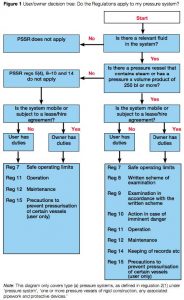
Pressure Systems Safety Regulations – Flow Chart
Regulation 7 Safe operating limits
This regulation complements regulation 5 which holds the designer, manufacturer and supplier responsible for providing adequate information about the system or its component parts. It prohibits the user/owner from operating the system or allowing it to be operated before the safe operating limits have been established.
The exact nature and type of safe operating limits which need to be specified will depend on the complexity and operating conditions of the particular system.
Small simple systems may need little more than the establishment of the maximum pressure for safe operation.
Larger systems are likely to need a wide range of conditions specified, maximum and minimum temperatures and pressures, nature, volume and flow rates of contents, operating time, heat input or coolant flow.
• What if the owner/user does not have sufficient competence to set the limits?
• Then an organisation which is competent to carry out the task should be used.
• So, who is responsible if the competent organisation gets it wrong?
• The owner/user is responsible for setting safe operating limits.
Note: In all cases, the safe operating limits should incorporate a suitable margin of safety.
Regulation 8 Written Scheme of Examination
This regulation is central to the concept of the PSSRs as a set of regulations designed to encourage planned regular inspections of pressure equipment. Most of regulation 8 supports the understanding of the roles and attributes of a competent person.
The responsibility for ensuring that a Written Scheme of Examination (WSE) is drawn up and that it is suitable lies entirely with the owner/user, as clearly stated in the scope of regulation 8 in clause 103.
The user of an installed system and the owner of a mobile system shall not operate the system or allow it to be operated unless he has a written scheme for the periodic examination by a competent person for the following parts of the system:
• All protective devices
• Every pressure vessel in which a defect may give rise to danger
• Every pipeline in which a defect may give rise to danger
• Those parts of the pipework in which a defect may give rise to danger
The WSE should be written and/or certified as suitable by a competent person who specifies:
• The nature and frequency of examinations.
• Any special measures needed to prepare the system for safe examination.
Note: Where appropriate the requirement for an examination before the system is first taken into use should be
specified in the written scheme of examination.
For equipment supplied in accordance with pressure equipment regulations (PER), the person who draws up or certifies the written scheme should consider whether an initial examination is appropriate and the form that any such examination should take. This consideration should take account of the results of the conformity assessment to which the equipment was subject before it was placed on the market.
Competent Person
The term ‘competent person’ refers not to the individual employee who carries out duties under the regulations but to the body which employs the person charged with the duties. Therefore, the definition of the competent person makes it clear that the legal duty to comply rests with a competent person’s employer and not with the individual unless that person is self-employed.
It is the responsibility of the owner/user to select a competent person capable of carrying out the duties in a proper manner with sufficient expertise in the particular system. In some cases, the necessary expertise will lie within the owner/users own organisation or the owner/user may act as the competent person responsible for compliance with the regulations.
Note: It is unlikely that one individual will have sufficient knowledge and expertise to act on their own. A competent person should be chosen who has a team of available employees with the necessary breadth of knowledge and experience.
In general terms a competent person should have:
• Staff with practical and theoretical knowledge and actual experience of the relevant systems.
• Access to specialist services.
• Effective support and professional expertise within their organisation and
• Proper standards of professional probity.
Attributes and role of competent persons;
The level of expertise needed by the competent person depends on the size and complexity of the system in question. Pressure systems are divided roughly into three categories but in practice, there are no clear dividing lines. The three categories should be taken as an indication of the range of systems covered rather than providing clear-cut divisions.
Each system should be individually assessed and an informed decision made on which of the categories is the most appropriate.
The three system categories are as follows:
1. Minor systems include those containing steam, pressurised hot water, compressed air, inert gases or fluorocarbon refrigerants which are small and present few engineering problems. Pipelines are not included.
2. Intermediate systems include most storage systems and process systems which do not fall into either of the other two categories. Pipelines are included unless they fall into the major system category.
3. Major systems are those which because of their size, complexity or hazardous contents require the highest level of expertise in determining their condition.
Note: See ACOP para 98 for details of all the above.
The attributes needed for competent persons who draw up or certify schemes of examination are as follows –
Minor systems
Staff. At least one member of staff qualified to Incorporated Engineer level with adequate relevant experience and knowledge of the law, codes of practice, examination and inspection techniques and understanding of the effects of operation for the system concerned.
Specialist services. Established access to basic design and plant operation advice, materials engineering and nondestructive
testing (NDT) facilities.
Organisation. Sufficient organisation to ensure reasonable document storage and retrieval system with ready access to relevant law, technical standards and codes.
Intermediate systems
Staff. Depending on the complexity of the system, at least one senior member of staff of Chartered Engineer or equivalent status in each relevant discipline and supported by technically qualified and experienced staff with knowledge of the law, codes of practice, examination and inspection techniques and understanding of the effects of operation for the system concerned.
Specialist services. In-house or clearly established access to design and plant operation advice, materials engineering and NDT.
Organisation. Clear supervisory arrangements with an adequate degree of formal organisation. Appropriate document storage and retrieval system,
Major systems
Staff. Depending on the complexity of the system, at least one senior member of staff of chartered engineer or equivalent status in each relevant discipline and supported by technically qualified and experienced staff with knowledge of the law, codes of practice, examination and inspection techniques and understanding of the effects of operation for the system concerned.
Specialist services. In-house or clearly established access to the full range of relevant specialist services in the fields of design and plant operation advice, materials engineering and NDT.
Organisation. Formal structure and clear lines of authority and responsibility set out in a written statement. Formal recruitment and training policies for staff. Effective document storage and retrieval system with ready access to the relevant law, technical codes and standards.
The competent person should ensure that the written scheme specifies:
Which parts of the pressure system need to be subject to examination as defined by the user/owner.
and
What types of examination are necessary and the intervals between them.
Scope
The user/owner should first establish which parts of the pressure system are pressure vessels, protective devices, or pipework as defined in the Regulations, and then decide which parts of the system should be included in the
written scheme.
Considerations
In general, pressure vessels should be included. All protective devices should be included. Pipework and other pressure-containing components can be excluded if there is no particular risk to its mechanical integrity and failure resulting in the sudden release of stored energy would not give rise to danger to persons. The user/owner should be able to justify any decision to exclude parts of the system from the scope of the written scheme. They should seek advice from a person with the appropriate and relevant technical expertise and experience.
Note: This may or may not be the Competent person as defined in the PSSRs.
Content of the WSE
As a minimum, the following information should be included:
1. Those parts of the system which are to be examined;
2. Identification of the item of plant or equipment;
3. The nature of the examination required, including the inspection and testing to be carried out on any protective devices;
4. The preparatory work necessary to enable the item to be examined safely;
5. Specify what examination is necessary before the system is first used, where appropriate;
6. The maximum interval between examinations;
7. The critical parts of the system which, if modified or repaired, should be examined by a competent person before it is used again;
8. The name of the competent person certifying the written scheme;
9. The date of the certification.
The nature of the examination should be specified in the written scheme.
• Out-of-service examination with the system stripped down,
• In-service examination with the system running under normal operating conditions.
• Some systems (for example fired equipment) may need to undergo both out-of-service and in-service examinations.
Note: The in-service examination should be completed as soon as reasonably practicable after the completion of the
out-of-service examination.
The following types of pressurised systems are likely to require a written scheme of examination:
a) Steam sterilising autoclave and associated pipework and protective devices;
b) Steam boiler and associated pipework and protective devices;
c) Pressure cooker;
d) Gas-loaded hydraulic accumulator, if forming part of a pressure system;
e) Portable hot water/steam-cleaning unit fitted with a pressure vessel;
f) Vapour compression refrigeration system where the installed power exceeds 25 kW;
g) Standard or narrow-gauge steam locomotive;
h) The components of self-contained breathing apparatus sets (excluding the transportable pressure
i) Fixed LPG storage system supplying fuel for heating in a workplace.
The following pressurised systems are unlikely to require a written scheme of examination:
• An office hot water urn (for tea making);
• A machine tool hydraulic system;
• Portable oxy-fuel gas welding sets; and
• An atmospheric oil storage tank.
Note: Be aware that a system may be covered by all the regulations, some of the regulations or none of the regulations.
Inspection Intervals
The competent person should use their judgment and experience to determine the appropriate interval based on the relevant information. Earlier legislation set out maximum examination intervals for some types of equipment that the competent person may consider as a guide.
Previous examples were:
• Steam plant 14 months
• Steam receivers generally in the range of 26–38 months
• Air receivers generally 24–48 months but up to 72 months
Review
The written scheme must be ‘suitable’ in all the circumstances so it should be reviewed from time to time, as stated within clause 116. A review can be carried out at any time but usually after an examination but before the report is submitted.
The competent person may decide that the period between each examination should be altered and this will mean revising the written scheme.
Regulation 9 Examination in accordance with the written scheme
Who carries out the examination in accordance with the written scheme?
Who is responsible for it and what should be in it?
• Users/owners must ensure that the equipment is not operated beyond the date specified in the current examination report.
• Reports should be received by the owner/user ‘as soon as is practicable’ (to ensure that where repairs have to be carried out within a short timescale there are no delays) but certainly no later than 28 days.
Next Examination date
The report will state the date beyond which the competent person has decided the system should not be operated for safety reasons, based upon the results of the examination under the written scheme. This must not exceed the period stated in the written scheme.
Postponement
There is a provision for the postponement of the next examination subject to the fulfilment of certain conditions.
It is for the user/owner to fulfill all these conditions before the examination can legally be postponed.
Unless the user or owner informs the competent person of an intended change of use, the assessment of the system’s fitness should be based on the current operating conditions and method of use continuing unchanged.
The competent person should assume that normal maintenance will be carried out as defined in regulation 2 under ‘examination’.
The report should be based on the actual condition of the system as found during the examination. At the end of the examination, the competent person should be satisfied that the protective devices, especially any safety valves have been tested and set correctly.
Note: Where protective devices have been removed during the examination and found to be defective the cause of the problem should be investigated further by the owner/user and the necessary corrective measures taken.
If repairs are carried out as a result of the examination, the report should include details of the fault and the remedial action taken even if the repair works are finished before the examination has been completed. All parts of the system covered by the scheme must be examined within the intervals specified in the written scheme of examination. Where there are several identical vessels on site operated by the same user, a form of staged examination may be used.
For example, a written scheme covers four identical vessels and specifies a frequency of examination of five years. It is acceptable to examine a different vessel each year within the group of four, provided they are all examined within the five-year period. The are other hazards not covered by these regulations that should be considered, such as:
• Means of entry
• Entry into confined spaces
• Lack of oxygen
• Hazards of toxic substances
• Asbestos in lagging
Note: The risks posed by these hazards must be assessed to comply with the regulations of the management of Health and Safety at Work Regulations 1999 and other more specific provisions and appropriate precautions should be taken.
Regulation 10 Action in case of imminent danger
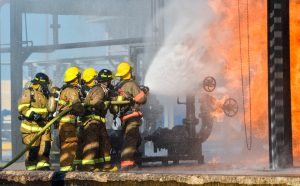
Applies only to serious defects requiring immediate attention. The competent person should notify the user/owner immediately in a written report so that appropriate action can be taken to prevent danger.
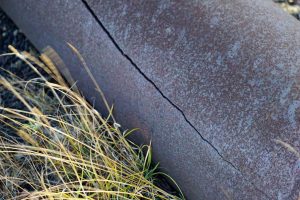
steel pipe crack
The report is separate from and does not replace the report of the examination under the written scheme of examination required by regulation 9. Defects that are identified only as a result of the competent person’s examination, rather than as a result of checks under the maintenance regime, can point to failings in the general management of the system.
Although the defect may be rectified immediately it is identified, the competent person should still complete the report to the user/owner.
Note: The relevant enforcing authority must be notified by sending a formal written report within 14 days.
The full sequence of events for reporting imminent danger under the Pressure System Safety Regulations, is as follows:
1. The competent person immediately produces a written report identifying the system and specifying the repairs, modifications or changes required and gives it to the user/owner.
2. The user/owner ensures that the system (or part thereof) is not operated until the necessary repairs, modifications or changes have been carried out.
3. The competent person sends a written report to the relevant enforcing authority within 14 days.
4. The competent person produces a report of the examination under the written scheme (regulation 9) and sends it to the user/ owner within 28 days.
Mobile systems
For mobile systems, the date of the next examination must be marked on the system. A permanent form of marking, such as engraving, is not required. It will generally be sufficient if the date is painted on the equipment.
Format of reports
No particular format is laid down for the report, the format can be chosen to fit in with the record-keeping systems of the user/owner and competent person.


